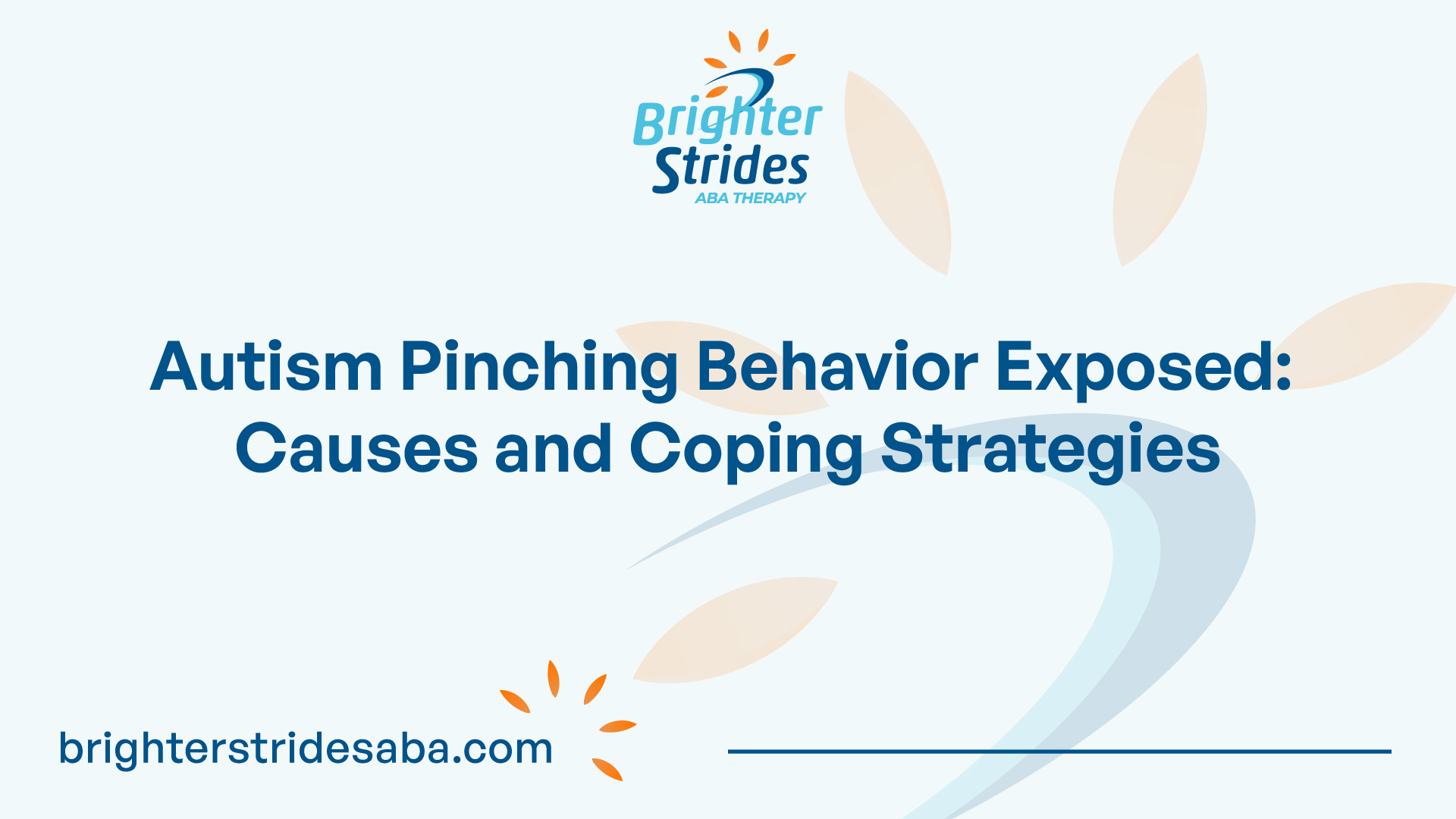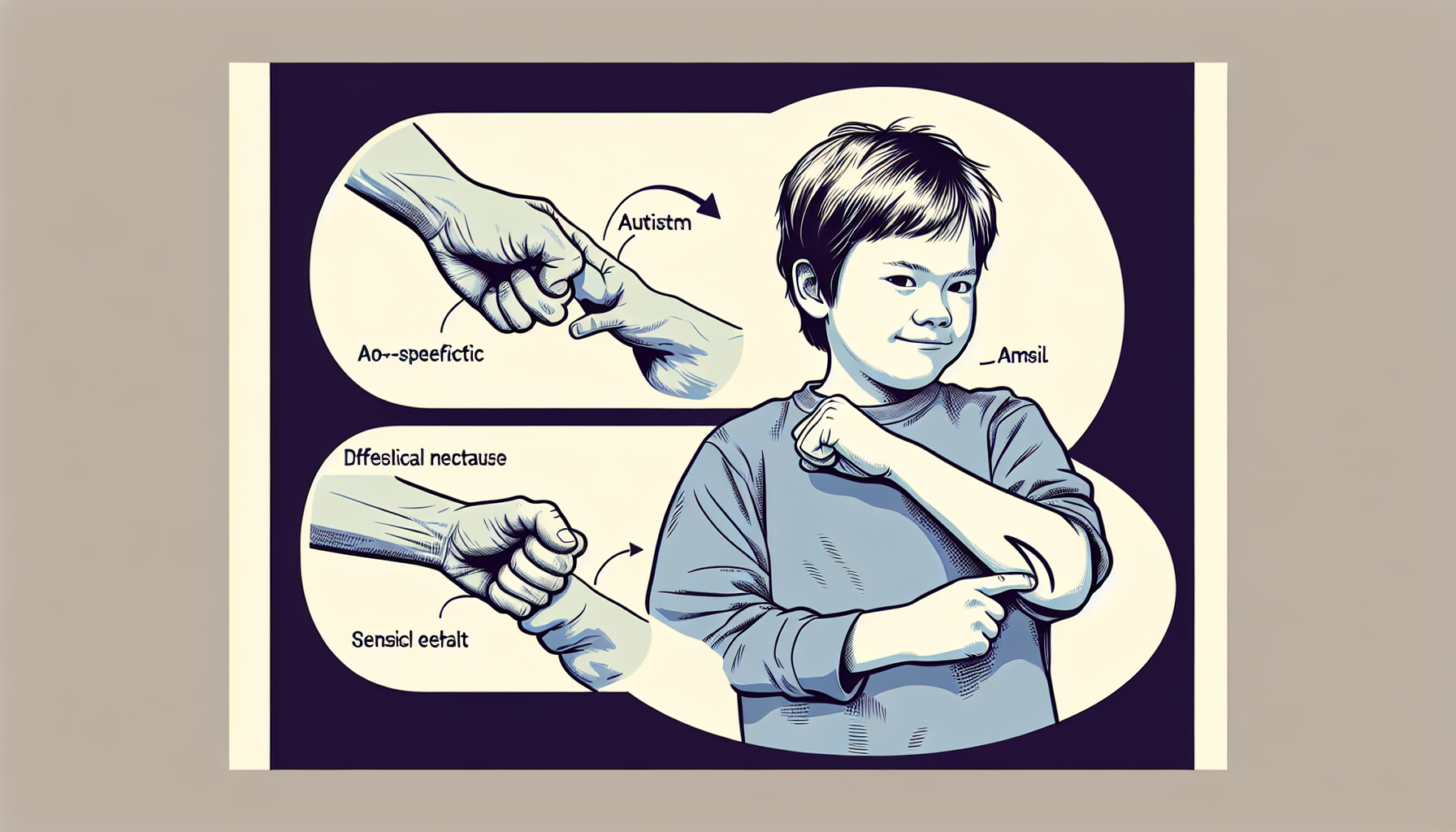Understanding Pinching Behavior
Pinching behavior is a common occurrence among individuals with autism, particularly children. It involves the act of using the fingers to squeeze or pinch oneself, others, or objects [1]. Understanding the definition and characteristics of pinching behavior, as well as its causes and triggers, can provide insights into this behavior and guide the development of effective coping strategies.

Definition and Characteristics
Autism pinching behavior refers to the act of gripping or squeezing an object or another person’s skin using one’s fingers or nails with varying degrees of pressure [2]. It is important to note that pinching behavior can manifest differently in each individual. Some common characteristics of pinching behavior in autism include:
- Repeatedly pinching oneself, others, or objects
- Varying levels of pressure applied during pinching
- Difficulty expressing or communicating needs or emotions
- Sensory seeking or sensory avoiding behaviors associated with pinching
- Potential engagement in pinching behavior as a form of self-stimulation or to seek sensory input
The specific characteristics of pinching behavior may vary from person to person, highlighting the need for individualized strategies and interventions.
Causes and Triggers
Pinching behavior in autism can have various causes and triggers, indicating a complex interplay of factors that contribute to this behavior. Some common causes and triggers include:
- Sensory Stimulation: Individuals with autism may engage in pinching behavior as a way to seek or avoid sensory input. For example, they may pinch themselves or objects to regulate their sensory experiences or to gain tactile stimulation.
- Communication and Expression: Pinching behavior can also be a form of communication or expression for individuals with limited verbal abilities. It may serve as a way to express frustration, discomfort, or a need for attention or interaction.
- Emotional Regulation: Difficulties in emotional regulation can contribute to pinching behavior. Individuals with autism may resort to pinching as a way to cope with overwhelming emotions or as a self-soothing mechanism.
Understanding the specific causes and triggers for an individual’s pinching behavior is crucial for developing effective strategies and interventions. By addressing the underlying factors, it is possible to develop coping mechanisms and support systems that can help manage and redirect pinching behavior in a positive and constructive manner.
Impact of Pinching Behavior
Pinching behavior in individuals with autism can have both physical and emotional/social consequences. Understanding these impacts is crucial for developing effective strategies to support individuals who exhibit pinching behavior.
Physical Consequences
Pinching behavior can result in physical consequences, affecting both the person exhibiting the behavior and the individual being pinched. The intensity and duration of the behavior can contribute to the severity of these physical effects. Some of the physical consequences may include:
- Pain: Pinching can cause discomfort and pain for both the person with autism and the person being pinched. The sensation of pinching can vary depending on the force applied and the sensitivity of the individuals involved.
- Redness and Bruising: The skin of the person being pinched may develop redness or bruising as a result of the pressure exerted during pinching. These marks can be visible and may take time to heal.
- Injuries: In some cases, pinching behavior can lead to more severe injuries, such as cuts or abrasions, especially if the behavior is aggressive or repetitive.
It’s important to prioritize the safety and well-being of individuals involved in pinching incidents and take appropriate measures to prevent physical harm.
Emotional and Social Effects
Pinching behavior can also have emotional and social consequences for individuals with autism. These effects can impact their well-being and relationships with others. Some of the emotional and social effects may include:
- Frustration and Anxiety: Individuals who exhibit pinching behavior may experience increased frustration and anxiety, especially if they struggle with communication or sensory challenges. The behavior may serve as a means of expressing their needs or discomfort.
- Negative Reactions from Others: Pinching behavior can elicit negative reactions from others, who may not understand the underlying reasons behind the behavior. This can lead to misunderstandings and strained relationships.
- Social Isolation and Lack of Social Skills: Pinching behavior can make it challenging for individuals with autism to interact with others. The fear of being pinched may cause others to avoid interacting with the individual, leading to social isolation. Additionally, the behavior may impede the development of essential social skills.
Understanding and addressing the emotional and social effects of pinching behavior is vital for fostering a supportive and inclusive environment for individuals with autism.
Pinching behavior in individuals with autism can serve different functions, including sensory stimulation, communication and expression, and emotional regulation. Recognizing the underlying reasons behind this behavior can guide the development of effective strategies for intervention and support.
Managing Pinching Behavior
Pinching behavior is a common challenge faced by individuals with autism. Understanding effective strategies for managing this behavior is essential for promoting their well-being and minimizing its impact on their daily lives. Two key approaches to managing pinching behavior are intervention strategies and creating supportive environments.
Strategies for Intervention
Implementing strategies for intervention is crucial in addressing pinching behavior in individuals with autism. These strategies aim to identify triggers, provide alternative stimulation, teach relaxation techniques, utilize positive reinforcement, and, if necessary, seek professional help. With these approaches, individuals with autism can learn appropriate ways to cope with their emotions and behaviors.

It is important to identify the specific triggers that lead to pinching behavior in order to develop effective intervention strategies. By understanding the underlying causes or events that provoke the behavior, caregivers and professionals can work towards addressing the root issue.
Providing alternative forms of stimulation can redirect the individual’s focus away from pinching. This may involve offering sensory objects, stress balls, or other tactile experiences that can serve as a substitute for pinching.
Teaching relaxation techniques, such as deep breathing exercises or engaging in calming activities, can help individuals with autism manage their emotions and reduce the frequency and intensity of pinching behavior.
Positive reinforcement is a valuable strategy for promoting appropriate behaviors. By rewarding individuals for displaying alternative ways of coping or engaging in positive interactions, caregivers and professionals can encourage the development of new behaviors while diminishing the occurrence of pinching.
In some cases, seeking professional help may be necessary to develop effective management strategies tailored to the individual’s specific needs. Professionals experienced in working with individuals with autism can provide valuable guidance and support.
Creating Supportive Environments
Creating a supportive environment is equally important in managing pinching behavior. By optimizing the surroundings and promoting a positive atmosphere, individuals with autism can feel more comfortable and less prone to engage in pinching behaviors.
Supportive environments for managing pinching behavior should consider sensory integration techniques, effective communication strategies, and social skill training.

Sensory integration techniques involve understanding and addressing sensory sensitivities. By providing appropriate sensory input and ensuring a comfortable sensory environment, individuals with autism can experience a reduction in pinching behavior. This may include using sensory tools, creating calming spaces, or incorporating sensory-friendly activities.
Effective communication strategies play a vital role in managing pinching behavior. Developing and teaching alternative ways of expressing needs, wants, and emotions can help individuals with autism communicate their feelings without resorting to pinching. This may involve using visual supports, sign language, or assistive communication devices.
Social skill training can enhance individuals’ ability to interact with others and navigate social situations more effectively. By providing opportunities for socialization, teaching appropriate social behaviors, and fostering understanding and acceptance, individuals with autism can develop positive relationships and reduce the likelihood of engaging in pinching behavior.
By implementing intervention strategies and creating supportive environments, caregivers, educators, and professionals can effectively manage pinching behavior in individuals with autism. It is important to tailor these strategies to the unique needs of each individual, seeking professional guidance when necessary. With the right support and interventions, individuals with autism can thrive and lead fulfilling lives.
Pinching Behavior in Public Settings
When it comes to individuals with autism and their pinching behavior, managing this behavior in public settings can present unique challenges. The increased sensory input and social demands of public places can contribute to the occurrence of pinching behavior. It is important to understand these challenges and implement appropriate strategies to address them effectively.
Challenges and Strategies
Pinching behavior can be particularly challenging to manage in public places. The presence of unfamiliar surroundings, crowded spaces, and heightened sensory stimuli can trigger or exacerbate pinching behavior in individuals with autism [1].
One strategy to address pinching behavior in public settings is to establish clear expectations and rules. Providing individuals with autism with clear guidelines and boundaries can help them understand appropriate behavior in different environments. Visual supports, such as social stories or visual schedules, can be beneficial in reinforcing these expectations.
Another effective strategy is to teach alternative coping mechanisms. Providing individuals with appropriate sensory tools, such as stress balls or fidget toys, can redirect their focus and provide a safer and more acceptable outlet for their sensory needs. Teaching and reinforcing alternative coping strategies can help individuals manage their emotions and sensory experiences in public settings.
Importance of Sensory Considerations
Sensory considerations play a crucial role in managing pinching behavior in public places. Individuals with autism often experience sensory sensitivities that can contribute to their pinching behavior [4]. Understanding and addressing these sensory sensitivities can be key to reducing the occurrence of pinching behavior.
Creating a sensory-friendly environment can help minimize triggers and promote a more positive experience for individuals with autism. This can involve considering factors such as lighting, noise levels, and the overall sensory environment of a public setting. Making adjustments, such as using dimmer lighting, providing quiet spaces or noise-canceling headphones, can help individuals feel more comfortable and reduce the likelihood of pinching behavior.
In addition, gradually exposing individuals to public settings and gradually increasing their tolerance can be beneficial. This approach, known as systematic desensitization, can help individuals become more accustomed to the sensory demands of public places over time.
By acknowledging and addressing the challenges of pinching behavior in public settings and incorporating sensory considerations, individuals with autism can have a more positive and successful experience in various social environments. Implementing strategies and creating supportive environments can help reduce pinching behavior, enhance social interactions, and improve overall well-being for individuals on the autism spectrum.
Seeking Professional Help
When it comes to managing pinching behavior in individuals with autism, seeking professional help can play a vital role in understanding and addressing the underlying causes. Professionals who specialize in autism and behavior management can provide valuable guidance, develop personalized intervention plans, and offer support to both the individual with autism and their caregivers.
Role of Professionals
Professionals, such as behavior analysts, psychologists, and therapists, have the expertise and knowledge to assess and analyze the pinching behavior in individuals with autism. They can conduct thorough evaluations to identify the triggers and patterns that contribute to the behavior. Through careful observation and assessment, professionals can gain insights into the underlying factors that may be driving the pinching behavior.
Based on their assessments, professionals can then develop personalized intervention plans tailored to the specific needs of the individual. These plans may include strategies such as identifying triggers, providing alternative stimulation, using positive reinforcement, teaching relaxation techniques, and more [1]. The role of professionals extends beyond the individual with autism, as they also provide guidance and support to caregivers, helping them develop effective management strategies.
Collaborative Approaches
Collaboration between professionals, individuals with autism, and their caregivers is crucial for the successful management of pinching behavior. By working together, a collaborative approach can be developed, taking into account the unique needs and goals of the individual. This approach ensures that everyone involved is actively participating in the intervention process.
Collaboration may involve regular communication and feedback between professionals and caregivers, which helps in monitoring progress and making necessary adjustments to the intervention plan. Professionals can also provide training to caregivers, equipping them with the knowledge and skills needed to implement strategies consistently and effectively.
Furthermore, professionals may collaborate with other specialists, such as speech therapists, occupational therapists, or sensory integration therapists, to address specific areas of concern that may be contributing to the pinching behavior [5]. This multidisciplinary approach ensures a comprehensive and well-rounded intervention plan for managing pinching behavior in individuals with autism.
Seeking professional help is an important step in managing pinching behavior in individuals with autism. Professionals can provide valuable insights, develop personalized intervention plans, and offer support to both the individual and their caregivers. Through a collaborative approach, effective strategies can be implemented to help individuals with autism overcome pinching behavior and improve their overall well-being.
Supporting Individuals with Autism
When it comes to supporting individuals with autism who engage in pinching behavior, there are several important strategies to consider. By implementing coping mechanisms and fostering empathy and understanding, caregivers and those around them can provide meaningful support.
Coping Mechanisms
Pinching behavior in individuals with autism can serve different functions, such as self-stimulation or self-soothing, providing sensory input that helps regulate their emotions or reduce anxiety. It can also be a way of expressing frustration, seeking attention, or communicating a need or discomfort. It is crucial to approach this behavior with empathy and understand that it serves a purpose for the individual engaging in it.
Encouraging the use of visual supports, such as communication boards and social stories, can assist individuals with autism in effectively communicating their wants, needs, and physical discomforts, reducing the likelihood of distressed behavior. Rewards and motivators can also be effective in reinforcing positive behaviors.
Empathy and Understanding
Empathy and understanding play a vital role in supporting individuals with autism who engage in pinching behavior. By recognizing that pinching behavior is not a deliberate attempt to cause harm, but rather a way to cope with various emotions or communicate their needs, caregivers and those around them can approach the situation with patience and compassion.
It is important to create an environment that fosters understanding and acceptance. Educating family members, friends, teachers, and peers about autism and pinching behavior can help reduce stigma and promote empathy. Encouraging open and honest communication allows for a better understanding of the individual’s needs and challenges.
By actively listening to individuals with autism, caregivers can gain insights into their experiences and perspectives. This helps in tailoring support strategies that address their specific needs and preferences. Providing a safe and supportive space where individuals with autism feel understood and accepted can positively impact their overall well-being and self-esteem.
Supporting individuals with autism requires a collaborative approach involving caregivers, professionals, and the community. By working together, sharing knowledge, and implementing effective strategies, we can create an inclusive and supportive environment that enhances the quality of life for individuals with autism and helps them thrive.
Remember, each individual with autism is unique, and strategies that work for one person may not work for another. It’s essential to be flexible, patient, and adaptive in our approach, continuously learning and growing to provide the best possible support for individuals with autism and their families.
References
- https://www.goldenstepsaba.com/resources/autism-pinching-behavior/
- https://www.supportivecareaba.com/aba-therapy/what-is-autism-pinching-behavior
- https://www.goldstarrehab.com/parent-resources/what-is-autism-pinching-behavior
- https://www.thetreetop.com/aba-therapy/autism-pinching-behavior
- https://www.abtaba.com/blog/autism-pinching-behavior/
- https://www.totalcareaba.com/autism/autism-pinching-behavior
- https://www.autism.org.uk/advice-and-guidance/topics/behaviour/distressed-behaviour/all-audiences




